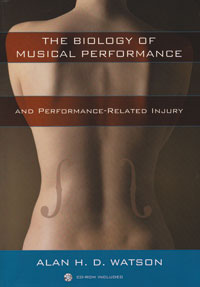 Alan H.D. Watson’s book, The Biology of Musical Performance and Performance-Related Injury is the book you have been waiting for, even if you were unaware that you needed it. For the first time, a medical professional has written a comprehensive book that explains what the body does, how it operates, and why it hurts sometimes.
Alan H.D. Watson’s book, The Biology of Musical Performance and Performance-Related Injury is the book you have been waiting for, even if you were unaware that you needed it. For the first time, a medical professional has written a comprehensive book that explains what the body does, how it operates, and why it hurts sometimes.
Watson is a senior lecturer in anatomy and neuroscience in the School of Biosciences at Cardiff University in Wales. He also has a lifelong interest in musical performance and plays French horn, flute, and keyboard instruments. His biography is far more extensive than this, but suffice it to say he is eminently qualified to write on this subject.
The Preface states that teachers rely on “subjective experience” that “sometimes rest on erroneous notions of the way in which the body works. One of the reasons for this is that our conscious sensations do not always provide a reliable guide to what our body is doing…. The object of this book is to help performers overcome this barrier by presenting them with accurate information on the biological principles that underlie their craft.”
The book is organized into ten chapters:
1. Introduction to the Tissues of the Body
2. Posture and the Back in Musical Performance
3. The Shoulder, Arm, and Hand: Structure and Problems
4. Breathing in Singing and Wind Playing
5. The Voice: Management and Problems
6. The Embouchure and Wind Playing
7. The Structure and Organization of the Brain
8. How the Performance of Music Affects the Brain
9. Hearing and the Processing of Musical Sound by the Brain
10. Performance-Related Stress and Its Management
Accompanying the book is a CD of teaching materials that include anatomical drawings in color of all the drawings in the text, video files, Power Point animations, sound presentations, and an extract from Smetana’s quartet Ma Vlast with a musical representation of tinnitus.
Watson addresses questions that musicians need answers to. In the interest of this review, I looked up flute in the index and found no less than 17 citings, some with multiple pages. For example, there are several paragraphs on flute vibrato in which he discusses the diaphragm vs. throat debate. He writes about focal dystonia, the benefits of using the larynx, vocal folds, and glottis in tone production, and what the assymetrical flute position does to the spine, neck, and shoulders.
Each chapter concludes with a lengthy list of references from which further information can be sought. This is a scholarly read, and it is long – 350 pages. As I read through it, I felt that I should take notes, highlight various passages, and digest them over a period of time. Because the language of medicine is unfamiliar to me and probably is to you, the terrain is a bit steep at times, but Watson tries to explain everything so that a musician can understand. He uses the appropriate terms for muscles and nerves, etc., but he defines them first so the layperson can grasp the meaning of his words. He does not write down to the reader or oversimplify the content.
I highly recommend this book to every flutist – teacher or performer. Every college library should also own a copy. It debunks many of the myths that our profession has subscribed to over the centuries, and it lays out the foundation for why those myths were erroneous in the first place. It is not that the teachers who went before us taught misinformation. They did the best they could with what they knew, felt, and sensed. They simply didn’t have the correct information. Even if it had been available in medical books and treatises of their day, most of those were written in such a way that they would have needed a medical degree to decipher them.
The reading and assimilation of this information will require an openness to new ideas and an attitude for change. If your natural tendency is to tell students to “support from the diaphragm,” you may find that this book makes you uncomfortable. So be it. Dive in anyway, because we have to stop the circle of misinformation. Now that Watson has put the medical knowledge in our hands, we have the tools with which to do it.
The Biology of Musical Performance and Performance-Related Injury is published by The Scarecrow Presss, Inc. and was first released in January 2009. It is available in hardcover, paperback, and as a Kindle download for anywhere from $37 to $90.






